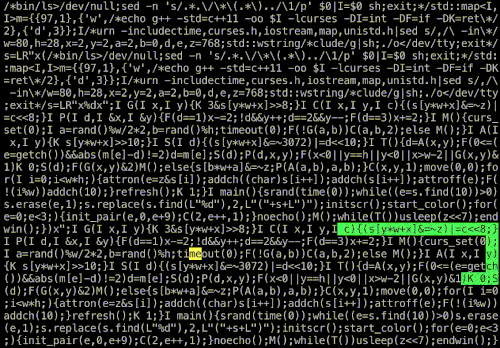C code can be compiled to run within a PDF using and old version of Emscripten that targets asm.js instead of WebAssembly. Then, all that's needed is a way to get key inputs, and a framebuffer for the output. Inputs are fairly straightforward, since Chromium's PDF engine supports text fields and buttons. Getting a good looking and fast enough framebuffer is a lot more of a challenge though.

The author produce a playable PDF, a file that can be read both as a PDF document and executed as a Windows program: https://github.com/mwenge/iatheory/releases/tag/0.1
This is polyglot program
Iridis Alpha is a classic of the 8-bit home computer era. An innovative, side-scrolling shoot-em-up for the Commodore 64 published by Llamasoft in 1985 that was notable then and now for its technical accomplishment.
IRIDIS ALPHA THEORY unpacks the assembly code of the game and pores over it in minute detail. There are also lots of pretty pictures.
Discovered in Paged Out! issue #5
"Qu’est-ce qu’un beau code ?" Voilà une question qui obsède un rien Xavier de La Porte. Mais peut-être a-t-il trouvé la réponse dans une thèse sur l’esthétique du code rédigé par un étudiant nommé Pierre Depaz. Vous le saurez à la fin de ce podcast.
Issue #5 is out !

Paged Out! is a new experimental (one article == one page) free magazine about programming (especially programming tricks!), hacking, security hacking, retro computers, modern computers, electronics, demoscene, and other similar topics.
Issue #2 includes a crazy prime Python quine ! (page 35) O.O
from random import*;import time,sys;import curses as h;w=h.initscr();h.noecho() #
P,Q,m,s,e,p,a,q=20,10,5,300,{0:"· ",1:"██"},[[[1,1]]*2,[[0,1,0],[1]*3,[0]*3],[[1#
,0,0],[1]*3,[0]*3],[[0,0,1],[1]*3,[0]*3],[[1,1,0],[0,1,1],[0]*3],[[0,1,1],[1,1,0#
],[0]*3],[[0]*4,[1]*4,[0]*4,[0]*4]],range,len;M,b=p[randint(0,6)],[[0]*Q for r #
in a(P)];h.cbreak();y,R,C,cr,l,d,n=lambda z,x,y:e[z[x][y]],0,4,0,1,s,p[randint(0#
,6)];w.nodelay(1);w.keypad(1);h.curs_set(0);A,B,sw=list,zip,{'U':'if not k(R,C'+#
',A(B(*M[::-1]))):M=A(B(*M[::-1]))','D':'V();R+=1','L':'if not k(R,C-1,M):C-=1',#
'R':'if not k(R,C+1,M):C+=1'};exec(('def k(R,C,se):\n for(r,c)in[(r,c)for c in '#
'a(q(M))for r in a(q(M))]:\n if se[r][c]>0 and(not(0<=R+r<P and 0<=C+c<Q)or b['#
'R+r][C+c]>0):return 1\ndef V():\n global R,C,M,n,l,d\n if(k(R+1,C,M)and R<1 an'#
'd sys.exit())or k(R+1,C,M):\n for(r,c)in[(r,c)for c in a(q(M))for r in a(q(M)'#
')]:\n if R+r in a(P)and C+c in a(Q)and M[r][c]>0:b[R+r][C+c]=M[r][c]\n M,n,'#
'R,C,d=n,p[randint(0,6)],-1,4,s+m-l*m\n for i in[j for j in a(P)if sum(b[j])>9'#
']:b[1:i+1]=b[:i];b[0],l=[0]*Q,l+1\ntry:\n while 1:\n o,z=a(q(n)),a(q(M));u=[('#
'r,c)for c in z for r in z];time.sleep(.001)\n for(r,c)in[(r,c)for c in a(Q)fo'#
'r r in a(P)]:`(r,c*q(e),y(b,r,c))\n for(r,c)in[(r,c)for(r,c)in u if M[r][c]>0'#
']:`(R+r,(C+c)*2,y(M,r,c))\n for(r,c)in[(r,c)for c in o for r in o]:`(r,22+c*2'#
',y(n,r,c)+"· · ")\n try:cr=(cr+1)%d;ch=w.getkey();exec(sw[ch[4:5]]);raise\n '#
'except:exec("if cr<1:V();R+=1");`(P,0,"level "+str(l))\nexcept:h.echo();w.keyp'#
'ad(0);h.nocbreak();h.endwin();print("level "+str(l))').replace('`','w.addstr'))#Amazing ! Reminds me of the International Obfuscated C Code Contest
This article shows how to construct a non-recursive zip bomb that achieves a high compression ratio by overlapping files inside the zip container. "Non-recursive" means that it does not rely on a decompressor's recursively unpacking zip files nested within zip files: it expands fully after a single round of decompression. The output size increases quadratically in the input size, reaching a compression ratio of over 28 million (10 MB → 281 TB) at the limits of the zip format. Even greater expansion is possible using 64-bit extensions. The construction uses only the most common compression algorithm, DEFLATE, and is compatible with most zip parsers.
$ python3 -m zipfile -e overlap.zip .
Traceback (most recent call last):
...
__main__.BadZipFile: File name in directory 'B' and header b'A' differ.This #JavaScript draws a #maze. Save as maze.html, open in browser.
While refreshing our RapiCover qualification kit, we looked harder for corner-cases and undefined behaviours. One of the more bizarre things we came across is the issue of code before the first case label of a switch statement. Such a simple concept turns out to have some rather unique challenges. Here's a fairly standard-looking C switch statement with five branches (five code sequences to choose among):
"Equation Group" ran the most advanced hacking operation ever uncovered.
It began when my coworker, despite already knowing how to program, was forced to take the intro level Computer Science course at my university. We joked with...
Personal blog of Eren, about computers, math and music
Voici un extrait de code malveillant retrouvé sur un serveur "piraté". Ce type de code permet à des individus peu scrupuleux de piloter à distance un ensemble de serveurs compromis, ce qu'on appelle un "botnet".
Le code est absolument illisible et il peut être amusant d'essayer de retrouver une version lisible du code à partir de sa version obfusquée.
The Internet's visual storytelling community. Explore, share, and discuss the best visual stories the Internet has to offer.
How James Somers reverse-engineered Google Docs to play back any document's keystrokes
Adventures in the land of JavaScript
